When it comes to historic landmarks, there is no greater wonder than the Ancient City of Perge, located on the outskirts of Antalya.
Perge Ancient City was once a thriving city and a major trade hub, though today it lies in ruins. That being said, it still retains much of its splendor and offers a fascinating glimpse into a bygone era.
Explore its grand theater, be amazed by the archaeological wonder of the stadium, marvel at the ruins of the agora, and see some well-preserved and intricate mosaics.
In this guide, we’ll share with you the history, landmarks to look out for, and how to visit the Ancient City of Perge from Antalya City Center.
Planning a trip to Antalya last-minute?
Make sure you book your tours, places to stay, and airport transfers ahead of time to ensure availability!
Here is our recommended airport transfer in Antalya:
- Airport Shuttle From Antalya Airport To City Center (Best way to get into town!)
Here are our recommended tours in Antalya:
- City Tour w/ Cable Car, Boat Trip and Waterfall (A must-do In Antalya!)
- Suluada Island Boat Trip (Secluded island for swimming and snorkeling)
- Traditional Turkish Bath with Massages
- Taurus Mountains Full-Day Jeep Safari (Great for exploring off the beaten path)
Here are our recommended places to stay in Antalya:
- Sky Kamer Hotel Antalya (Has seaview rooms in the historic center!)
- Megasaray Westbeach Antalya (All-inclusive resort right on the beach!)
- Hostel Vauge (Most famous hostel in Antalya!)
History of The Ancient City of Perge
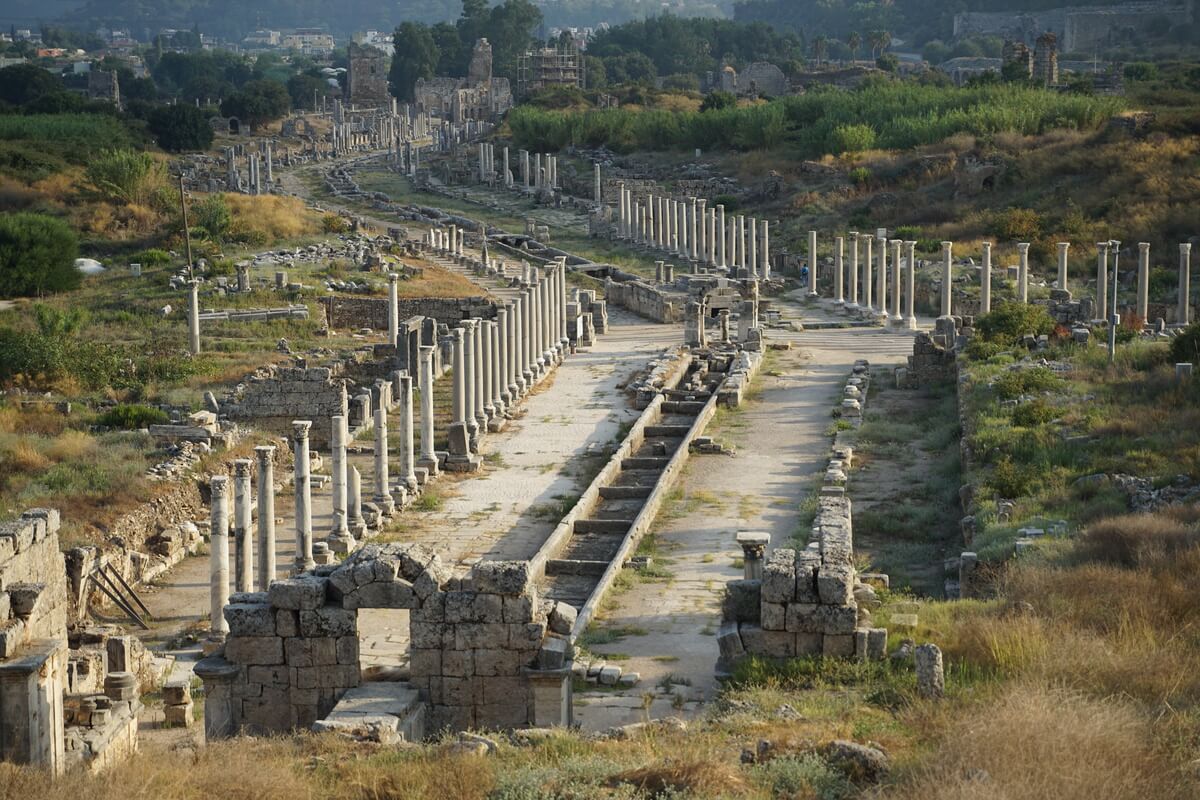
Perge Ancient City was founded by the Lycians in the 13th century (around 1209 BC at the latest) before it was conquered by the Greeks and renamed Pamphylia in 540 BC.
Its location on the Kestros (Aksu) River made it a prominent trading hub, extending from Side all the way to Ephesus, passing through Perge and Antalya. At the time, the coast was constantly plagued by Pirates, and so trading was mostly done by the rivers.
It is believed that Alexander the Great passed through Perge in 334 BC.
After the rule of Alexander ended, the city fell under the rule of the Diadochi empire of the Seleucids. During this period, the city underwent tremendous growth, both in its size and wealth.
The Seleucids built the walls around the city and started developing the city into a trading hub.
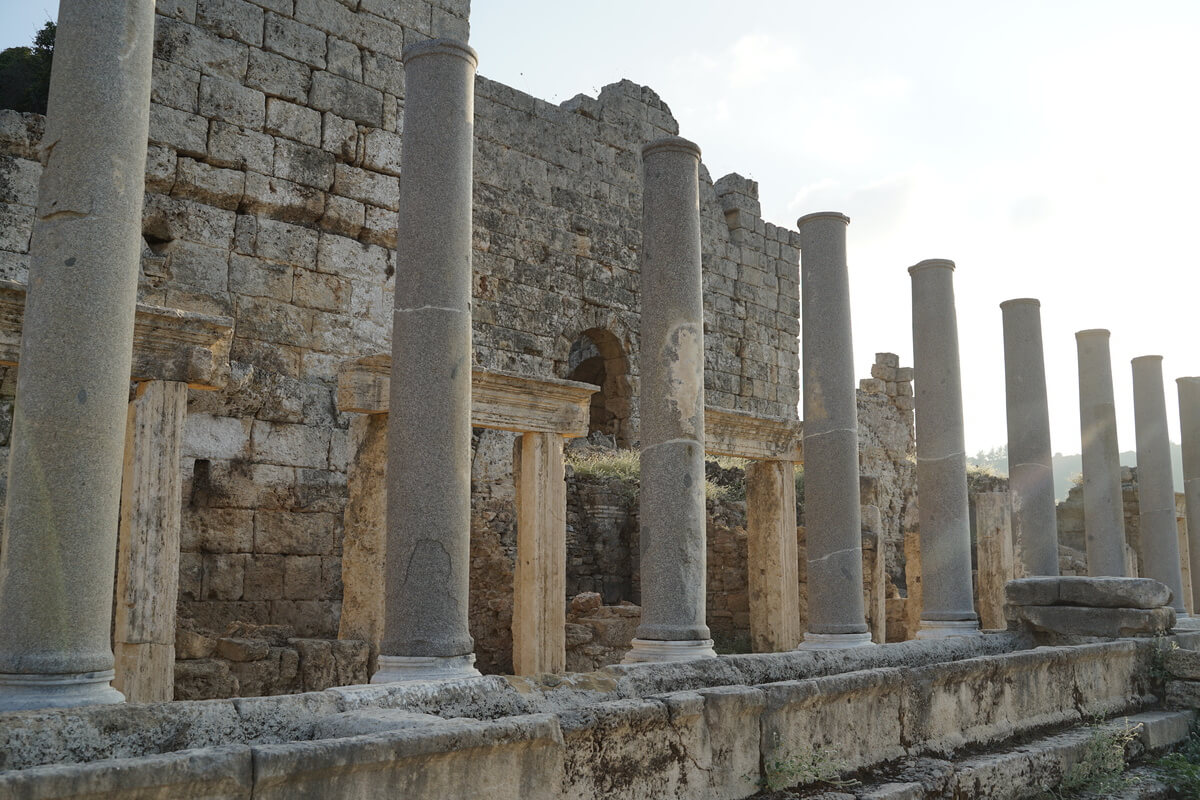
In 188 BC, the Romans conquered the Seleucids, and that’s when the city really flourished. They constructed most of the South side of the city, and by the 1st-3rd century AD, it became one of the most beautiful cities in Turkey‘s Anatolia region.
In 46 AD, Saint Paul ventured to Perge to preach the acts of God. It became a huge Christian center in the 4th century under the rule of Constantine the Great, and later became the official religion of the Roman Empire.
As well as the Apostle Paul, Perge is also well known for being home to mathematician, geometer, and astronomer Apollonius (262 BC – 190 BC) who was most famous for his work on conic sections.
It is believed that Perge thrived for many years, but started to decline in the 7th century AD after it was invaded by the Byzantines.
By the 12th century, Perge was mostly destroyed by the Seld and Arabs, and so it was abandoned.
How to Get To The Ancient City of Perge From Antalya
The distance between Perge Ancient City and Antalya is 19 kilometers and takes around 1 hour to get to using public transport, or 30 minutes by car.
To reach the Perge Ancient City from the city center of Antalya, your best option is to take the tram. The tram departs from İsmetpaşa tram station, near the Old Town, and goes directly to the Aksu tram stop.
From there it’s a 30-minute walk, but it’s easy and not too strenuous.
Alternatively, you can take a taxi if you don’t want to walk, but we didn’t see any taxis in Aksu so you will need to get one from the city center which will be expensive, though convenient.
Here is a map of the route to Perge Ancient City to guide you.
Things to See at The Ancient City of Perge
The wonderful thing about visiting Perge Ancient City is that you can wander around at your own pace.
The route through the city is very easy to follow since there is only one path and plenty of signs telling you where to go and what to see.
Be sure to check out the following monuments…
The Greco-Roman Amphitheatre
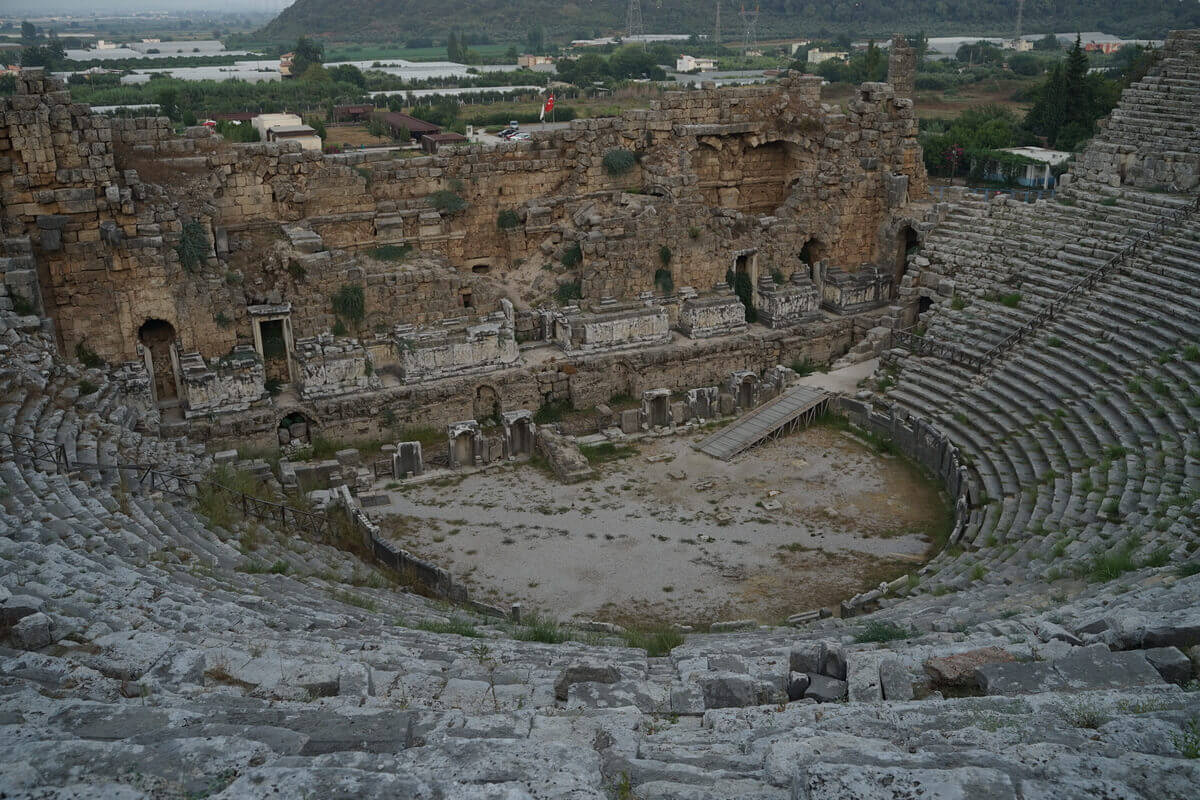

The theatre is not directly inside the Perge complex but is located across the road from the car park, nestled below the Kocabelen Hill, and so it’s often missed by tourists visiting without a guide.
You can enter the theatre using the same ticket as the Perge Ancient City, so you can either visit this first or at the end, but whatever you do, don’t skip it!
The theatre was built by the Romans and could occupy 12,000 people in its prime. There are 19 rows of seats on the lower level and 23 on the upper level. The stage is 52 meters long and decorated in Roman style.
In ancient times, the upper class would sit at the lower levels, and the working class at the top.
Based on the Greco-Roman architecture, it is believed the theatre was used for gladiator fights. There are five entrances to the stage, each decorated with intricately designed reliefs.
The Stadium
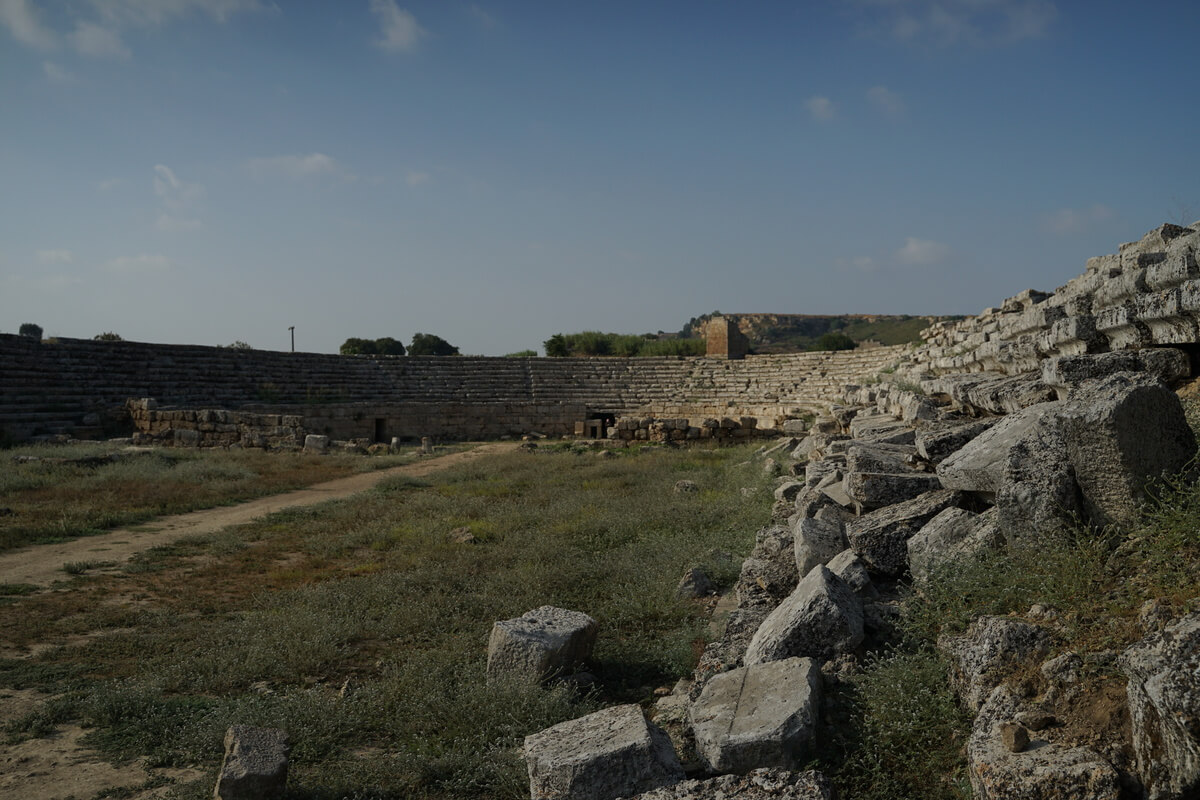
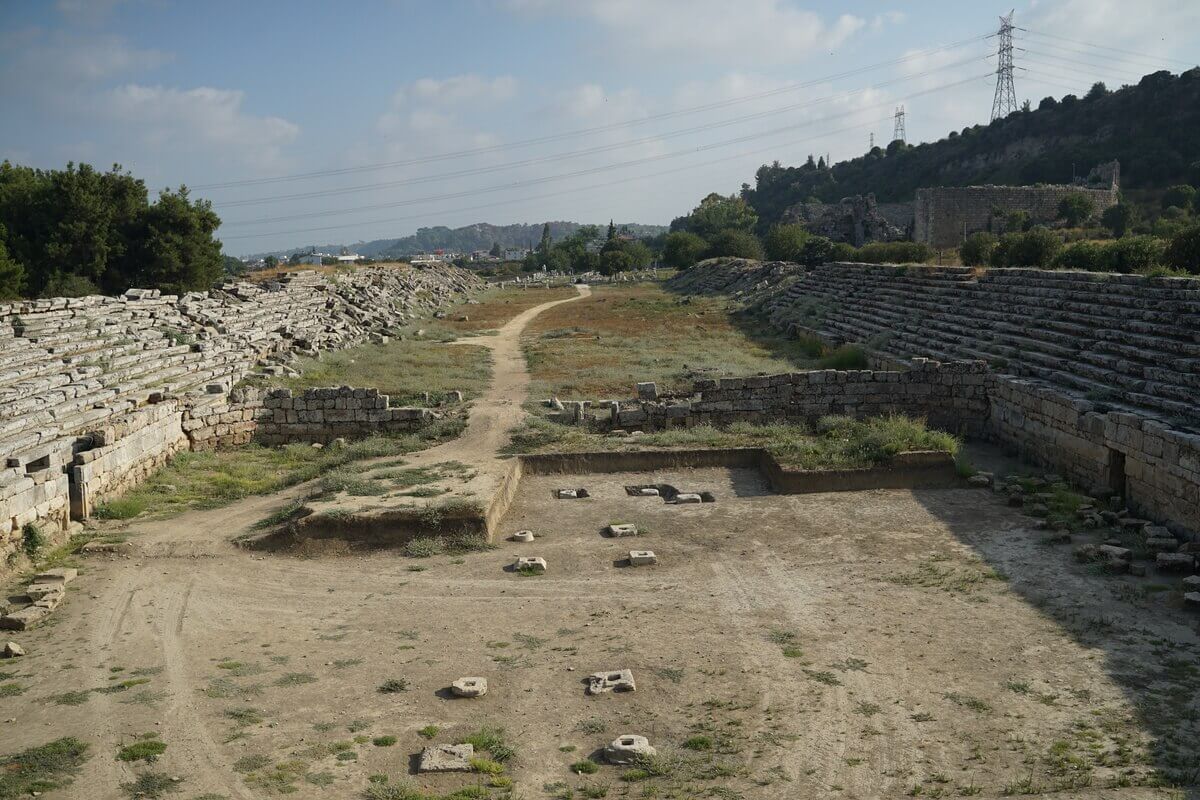
The Stadium is the first monument you see as you walk into the Perge Ancient City complex, though it’s easy to miss as it looks like a pile of rocks and grass from the entrance.
After you walk past the toilets, take a left and walk through the arches under the mound of grass, and you’ll be transported into the center of the stadium.
This U-shaped structure was believed to have been built in the second half of the first century AD and is 34 meters wide by 234 meters long, accommodating 12,000 people.
In its prime, there would have been 70 vaulted rooms under the seating area, which would have held shops and entrances to the stadium.
Hellenistic Walls & South Gate

After visiting the Stadium, wander back towards the WC and you’ll notice a large wall on your left. This is the remains of the Hellenistic walls, which fortified the city.
They are around 13-14 meters high and have two monumental towers. There are remains of the walls all around Perge, but this section near the entrance is in the best condition.
When you round the corner, you’ll find the South Gate, which is believed to have been constructed in the 3rd century AD, after the Romans started to lose power.
With this loss of power, came more fortifications as they struggled to defend the city. In fact, some of the baths were taken to be replaced by walls.
Circular Hellenistic Gates
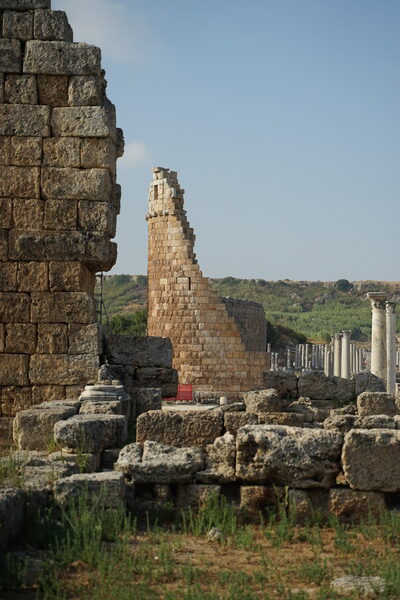
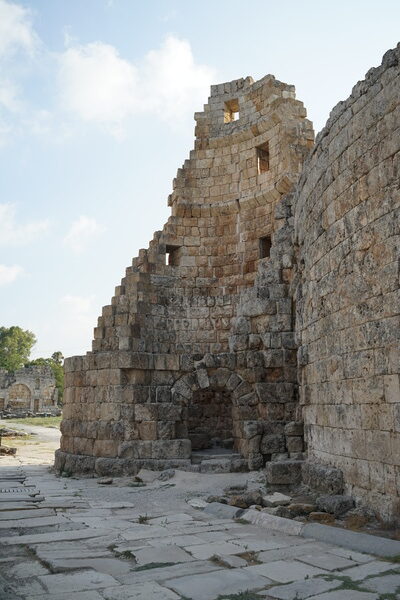
Perhaps the most iconic landmarks in the Ancient City of Perge are the two round towers, which you will see as you walk through the South Gate.
These towers were originally used for military purposes, but in the period of Hadrianus (120-121) they lost all importance and were abandoned. They measure 23 x 30 meters.
The towers were then restored as a gift to the city by Plancia Magna, who paid for the restoration of the two-story, three-arch gate and oval courtyard.
The courtyard was said to have been used for political propaganda purposes, as evidenced by inscriptions of names of financial benefactors who had financially supported Perge.
South Basilica
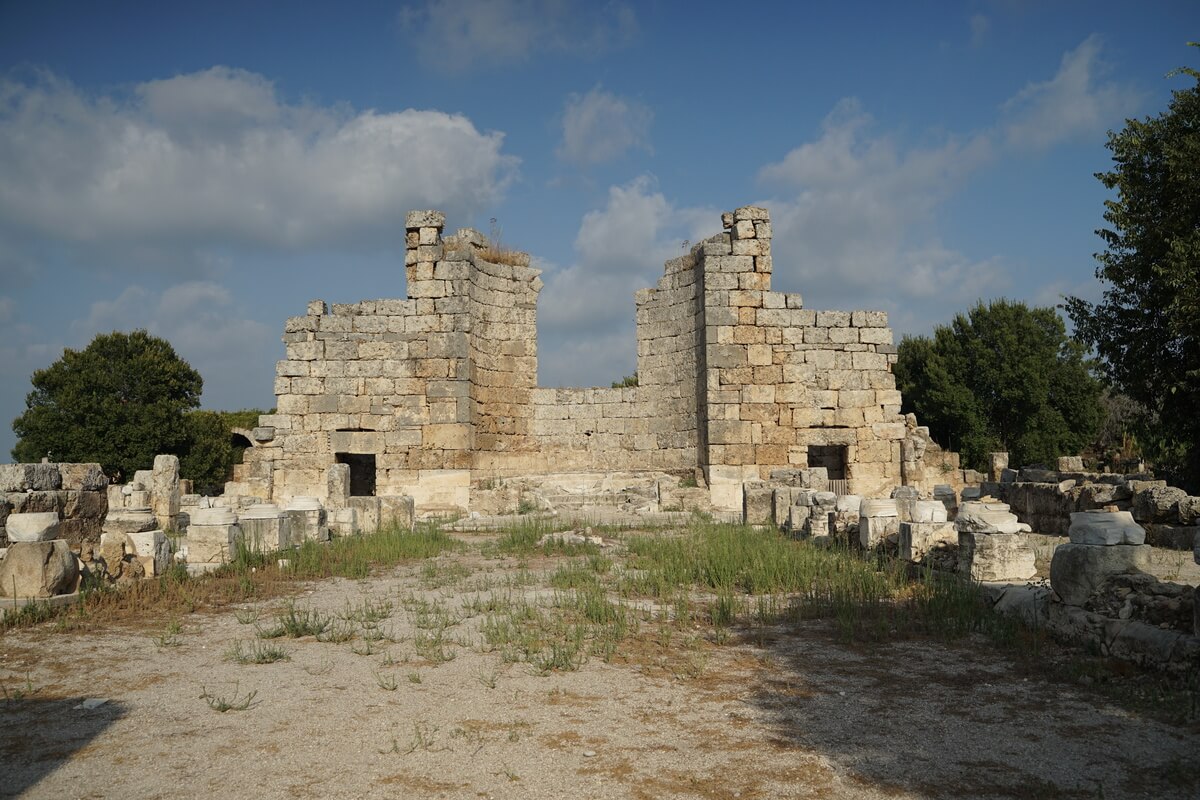
To the right of the South Gate is a small church, which is said to be the church that St. Paul visited in 47 AD.
The church, known as the South Basilica, was estimated to have been built in the 5th century AD and is still being excavated.
There isn’t much left of the church, but it’s an important site and worth stopping to admire.
South Baths
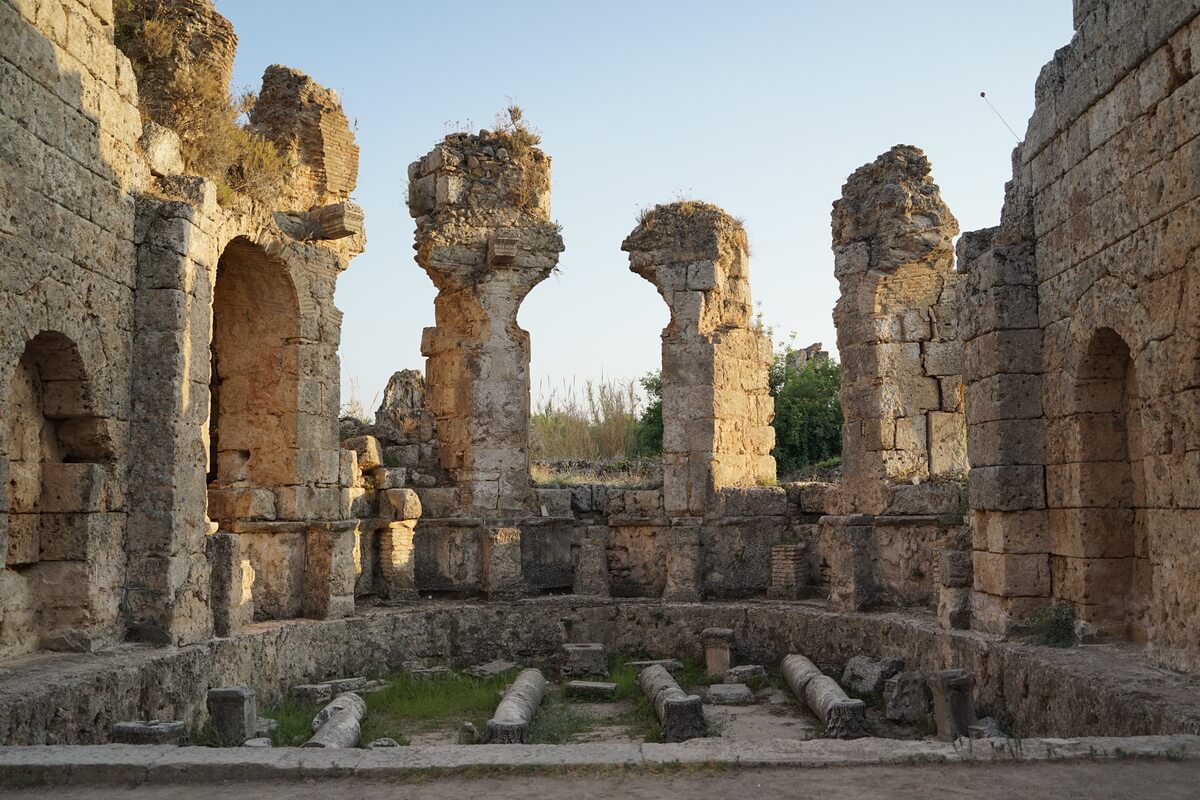
To the left of the round gate, you’ll find several remains of thermal baths, which were once the biggest thermal baths in Antalya and were excavated between 1978 and 1985.
As you walk around the remains of the baths, you can see where there were heating sections, cold plunge baths, and large communal baths.
Many statues and sculptures were found here, but they are now located in the Antalya Museum.
Agora
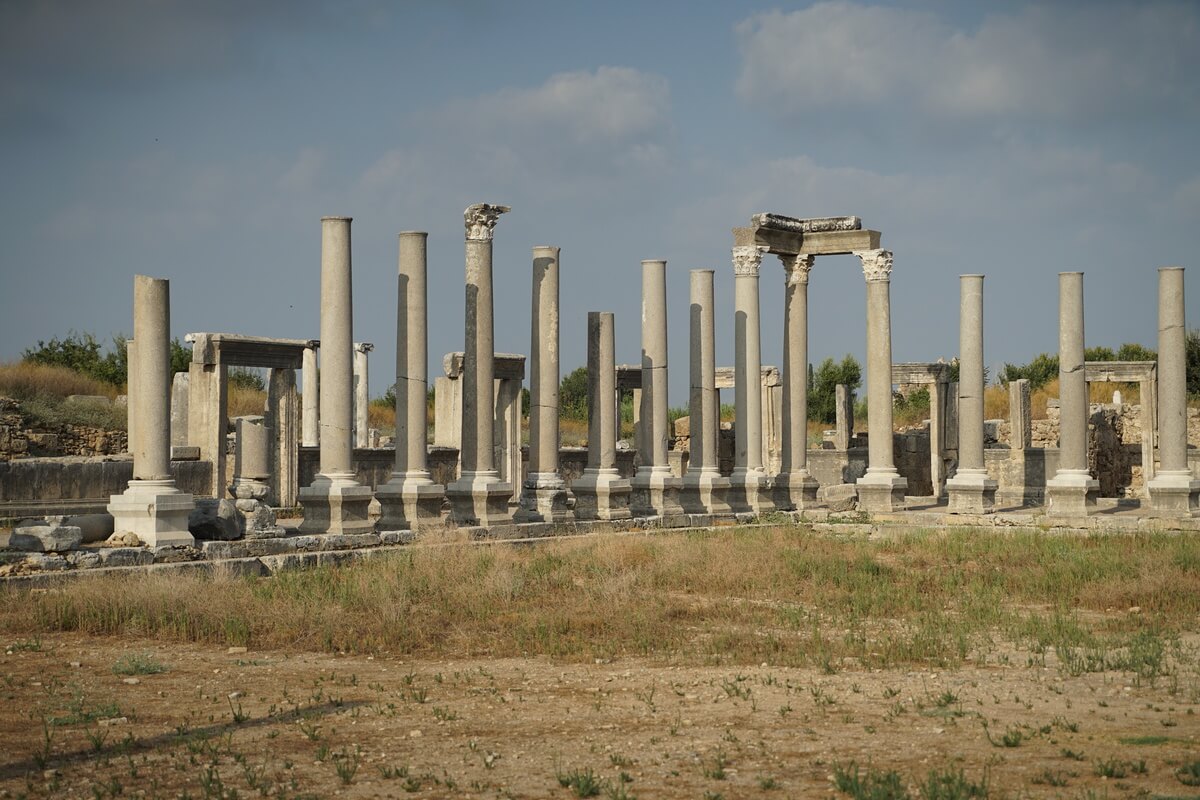
The Agora is a 76×76 meter squared space surrounded by columns. It was once a market square with a temple in the middle – though excavations have discovered a water pipe which means it could have been an agiasma.
In its prime, it would have been a bazaar, selling meat, fish, perfume, and luxury goods.
There were once shops behind the galleries which had mosaic flooring, though the mosaics are not visible at the site today.
It is said to have been the second largest Agora in Turkey in terms of size, and was once made up of three squares and was thought to have been two stories high.
Colonnaded Street
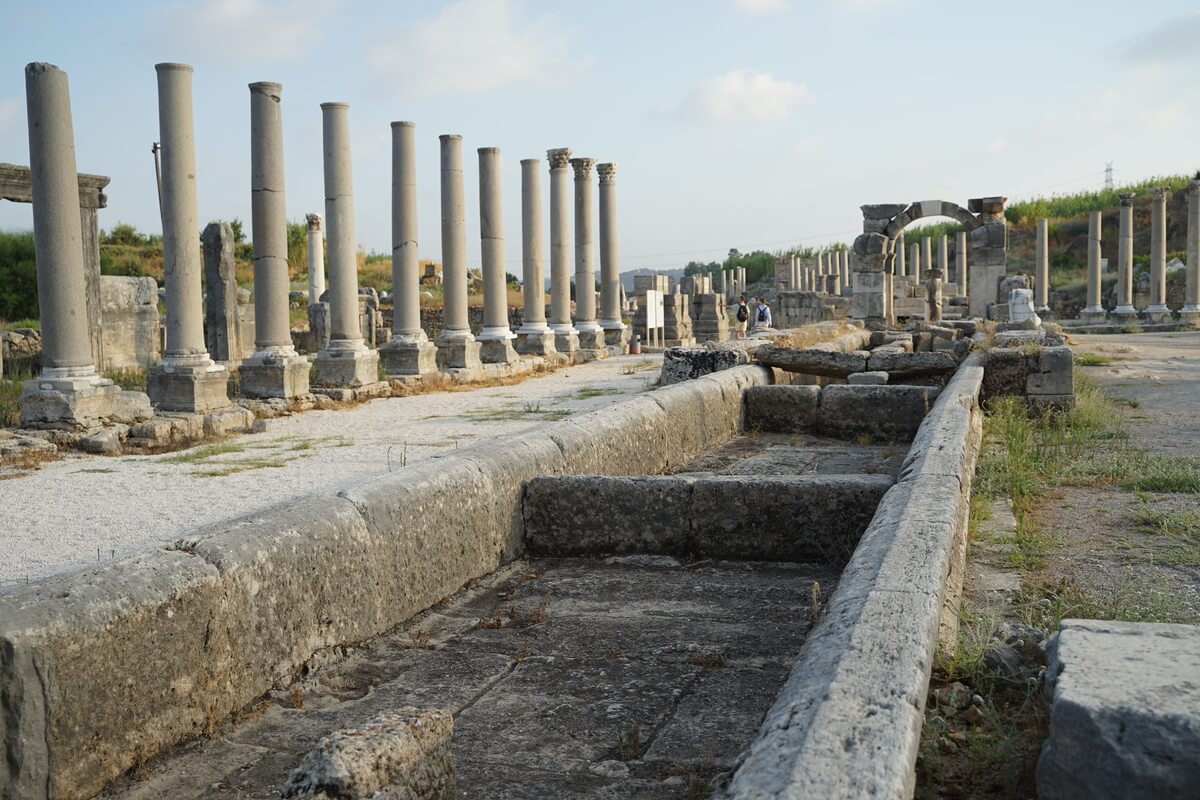
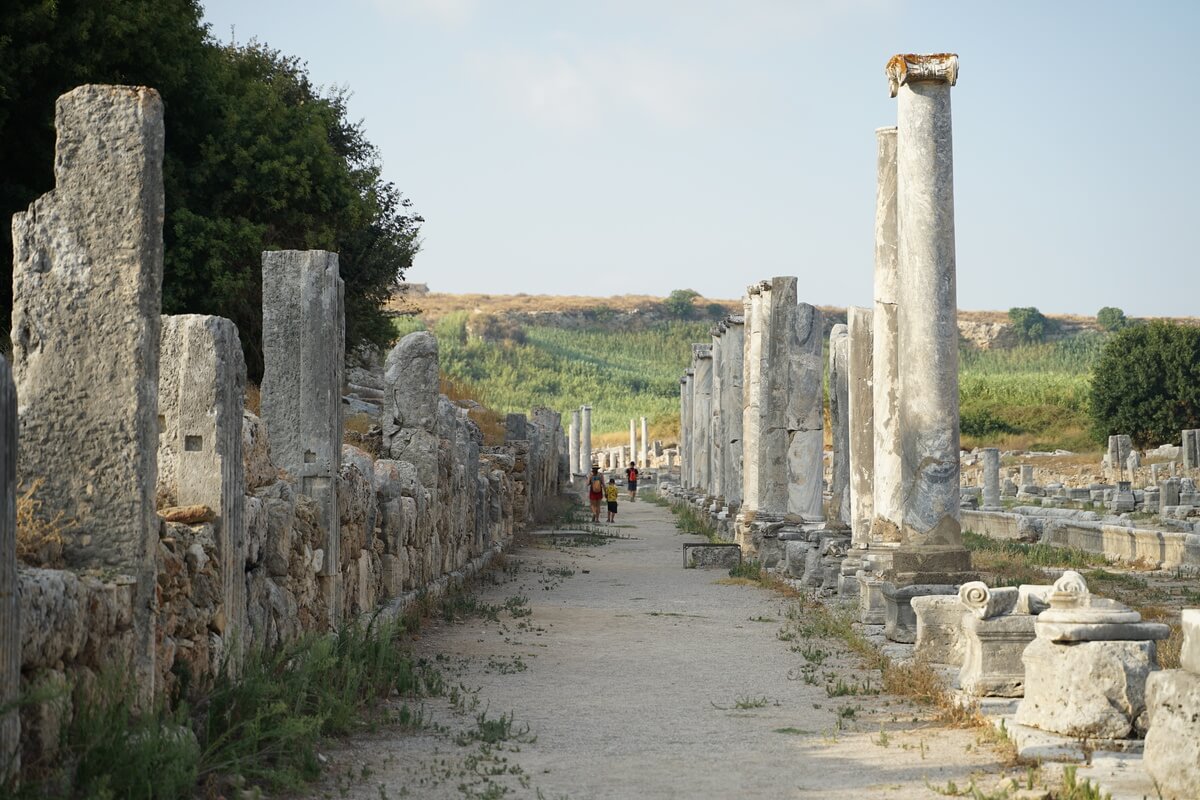
The colonnaded street runs through the middle of Perge Ancient City and connects the south to the north of the city. The street runs for around 480 meters long and is around 22 meters wide.
As you head north, you start to uncover the older section of the city.
The street is around 9 meters wide and has a walking area on either side for pedestrians, plus a water channel in the center. In its prime, it would also have been used by carts, since wheel marks have been discovered by archeologists.
On either side of the street are the remains of houses, galleries, and shops, which were once paved with mosaics.
Keep your eyes on the lookout for four columns with reliefs of Gods on them. However, when we visited, only three of them had their reliefs still intact, so we assumed one of the reliefs had succumbed to damage.
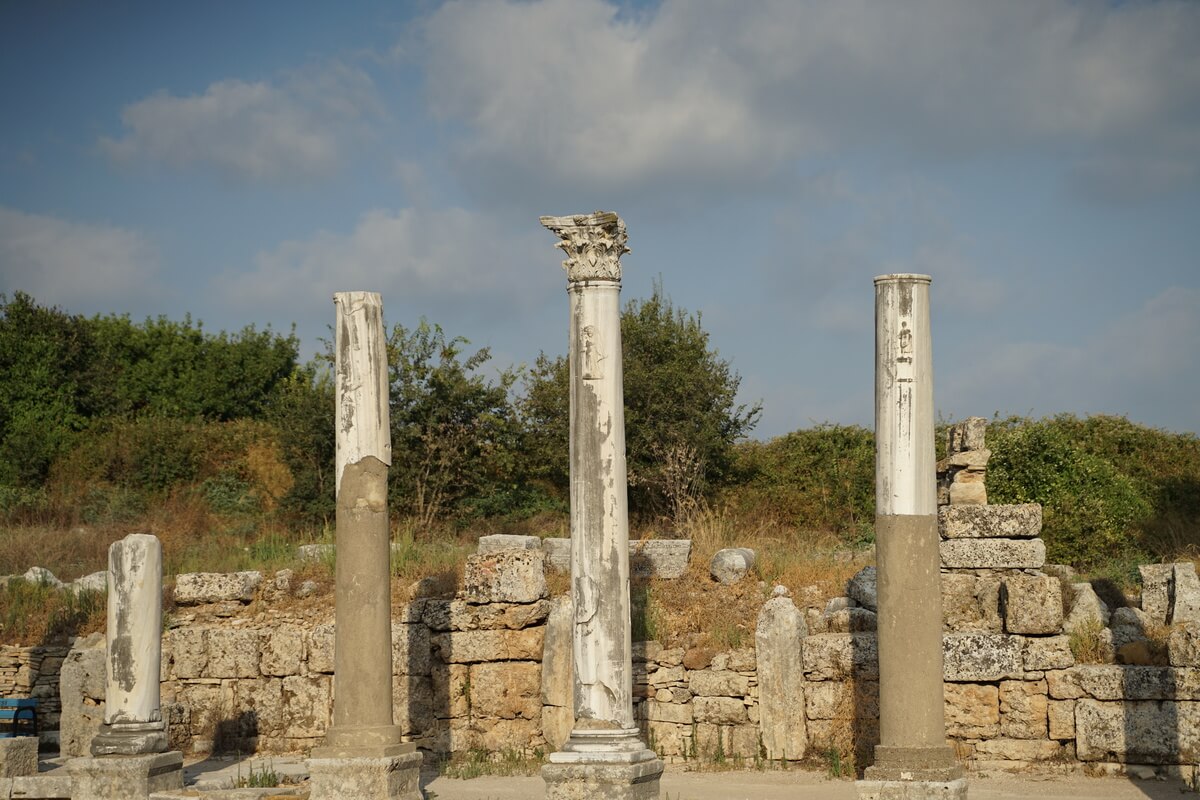
The Upper Nympheum (Fountain)
At the end of the colonnaded street, you will see the remains of an elaborate fountain, known as The Upper Nymphaeum.
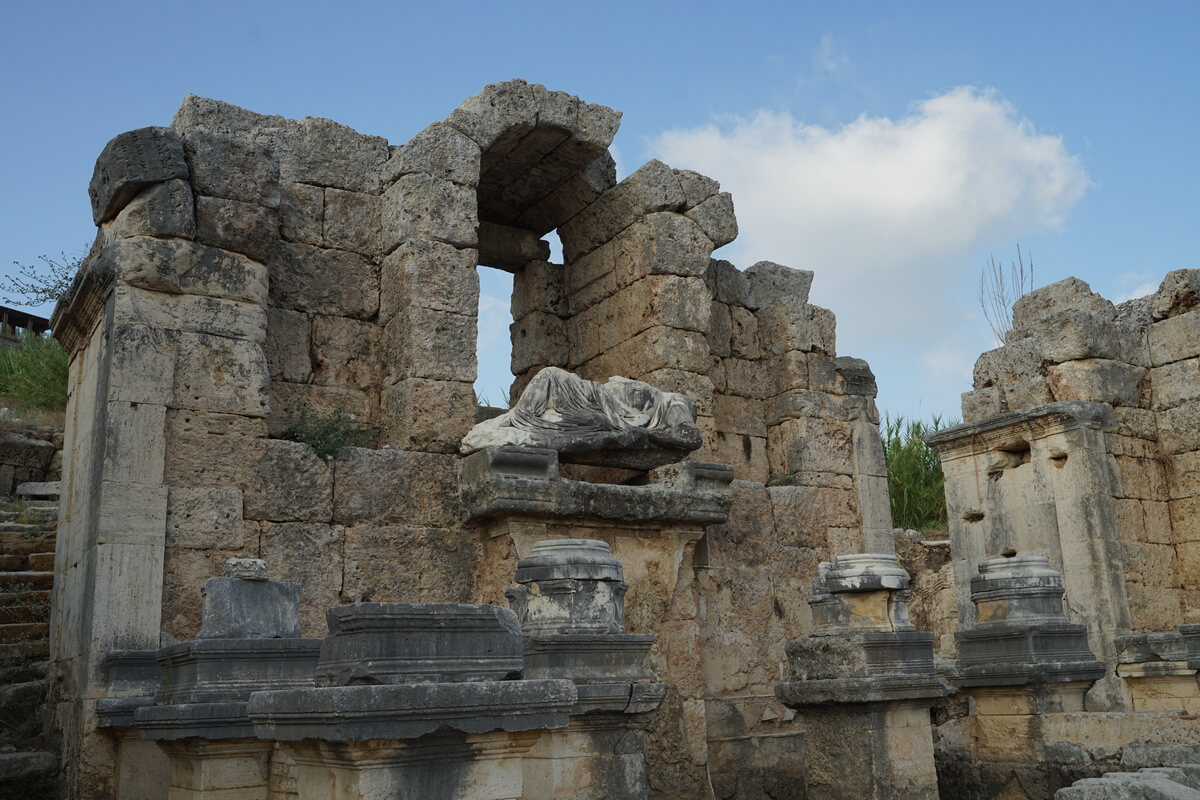
It was built in 117-138 AD during the reign of Hadrianus and has a double facade, extends over two stories, and measures 21 meters wide and 13 meters high.
In the center is a statue of the God Kestros in a lying-down position. It was also accompanied by statues of the gods Zeus, Artemis, and Apollon, but these statues are now in the Antalya Museum.
In ancient times, water would have poured out from under the statue.
If you venture behind the statue, you can see the remains of the pipes that connect to it.
Palaestra & Mosaics
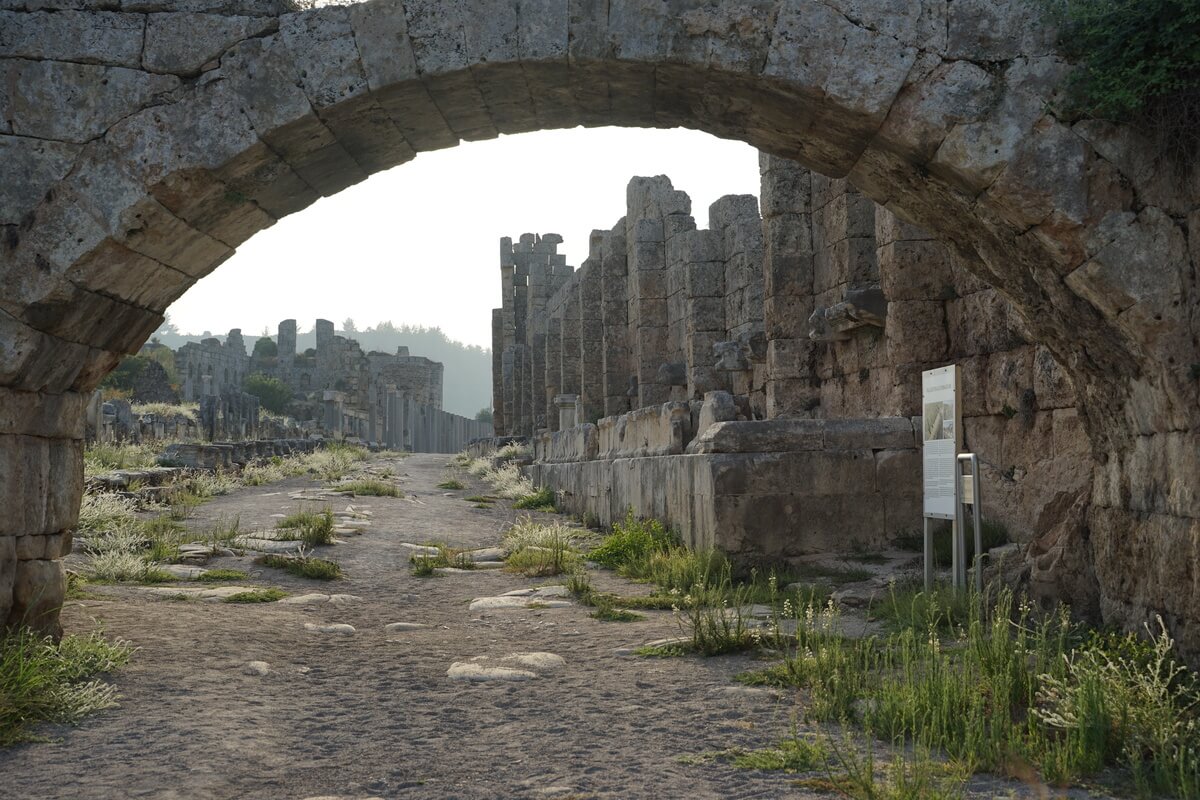
The Palaestra is to the left of The Upper Nymphaeum and was used as a place of sport and education, in other words, it was a gym.
The street is lined with well-preserved walls on the Southern side. Excavations by the Antalya Museum in 2013 revealed a podium to the south, which is supported by decorated parapets. It was thought it would have once been decorated with a pool and fountain.
An inscription tells us that it was dedicated to Emporer Nero by C. Julius Cornutus in the 1st Century AD.
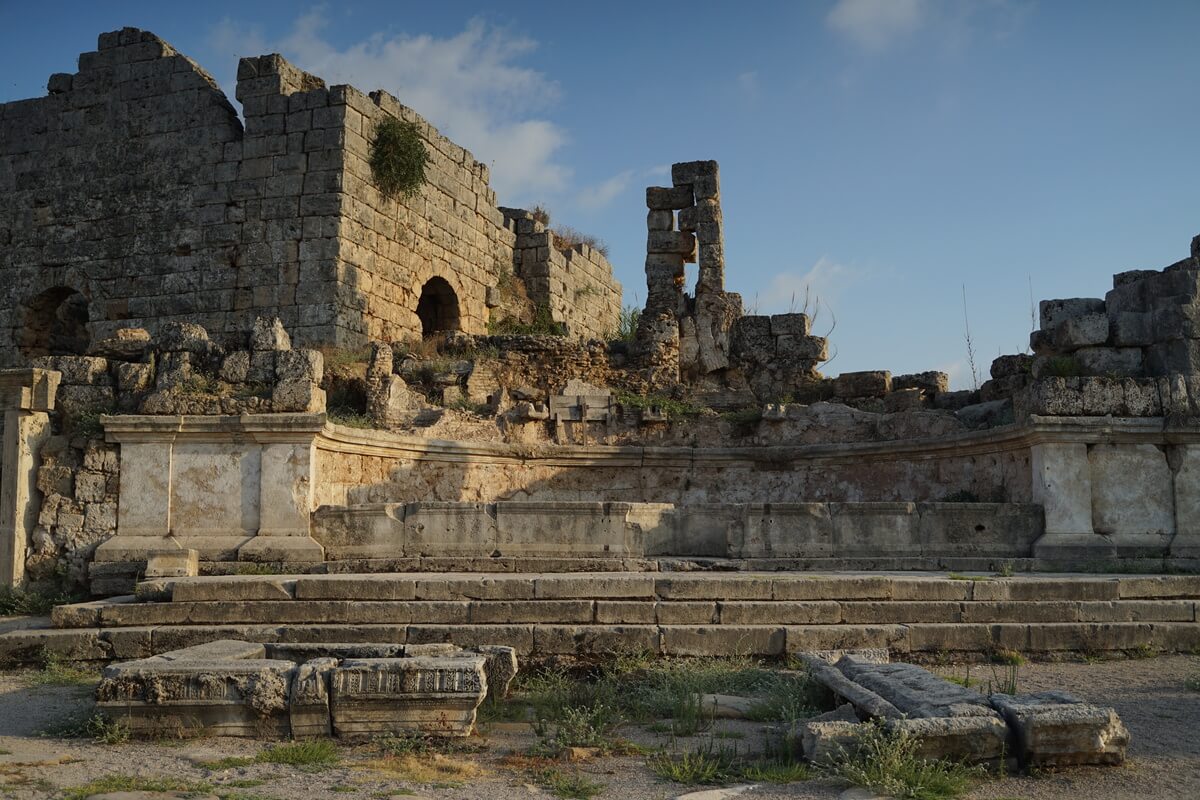
As you walk down this columned street, keep your eyes peeled for a building on the left which contains some well-preserved mosaics behind a barred fence.
The mosaic depicts a scene from the Trojan War, where Agamemnon sacrifices his daughter Iphigeneia. It was believed the room was once a religious site, where people lay offerings and performed sacrifices in the 2nd century AD.

It was believed to have been turned into a health center during the Byzantine period in the 5th-6th Century AD.
Tips for Visiting The Ancient City of Perge
Before you go, be sure to follow these words of advice…
- Wear comfortable footwear. When exploring the ruins, you will encounter rocky surfaces and some sandy areas that may be slippery. It’s best to wear trainers.
- If you’re visiting in the summer, go later in the day. We visited at 5.00 pm in August because it was just too hot in the daytime, and we still had 2-3 hours of exploring. It closes at 7.45 pm, so it’s possible to see it all even if you arrive late.
- Pack plenty of water. It can get hot when exploring the ruins since the sun reflects off the stone.
- Don’t bother with the guidebook in the gift shop. There is plenty of signage telling you what you look at and we found the information in the book to be sparse for 70 Lira. Not to mention it was riddled with spelling and grammar mistakes.
- Keep in mind it’s a bit of a walk from the tram. The best way to get to the city is by tram but it’s a 30-minute walk from there to the city. Don’t worry, you pass a BIM where you can get refreshments.
- Don’t play with the dogs. There are some stray dogs that wander around the car park and no matter how cute they are, don’t play with them, as they are feral.
FAQs About Visiting The Ancient City of Perge
Here is what people usually ask us about visiting The City of Perge…
What is Perge called today?
Perge, or Perga, is the name given to the city during Ancient Lycia Times, and when taken over by the Greeks, was known as the Ancient City of Pamphylia. Today, it is called by its Greek name, Perge Ancient City or The Ancient City of Perge.
What is the Perge Ancient City entrance fee?
The cost to visit Perge Ancient City as of August 2023 is 250 Turkish Lira ($9.30 USD) per person, or 60 Turkish Lira ($2.23) if you have the Antalya Museum Pass.
Which is better: Perge or Aspendos?
Having visited both Perge and Aspendos, we personally feel that Perge is better because there is more to see. While Aspendos is really cool, there is really only the theatre and a few ruins to see and takes less than an hour to explore. Perge however has far more ruins, including a theatre and stadium, so if you only have time for one, then we recommend Perge.
Final Thoughts
After exploring the Ancient City of Perge, it’s hard not to be amazed by the engineering and architecture of the ancient civilizations who lived here.
Whether you’re a history buff or you’re just looking to escape the Antalya beaches for a while, there can be no doubt that a trip to Perge will ignite the spark of curiosity within you.
We hope this guide helped you plan your trip and gave you some insight into what to see here.
